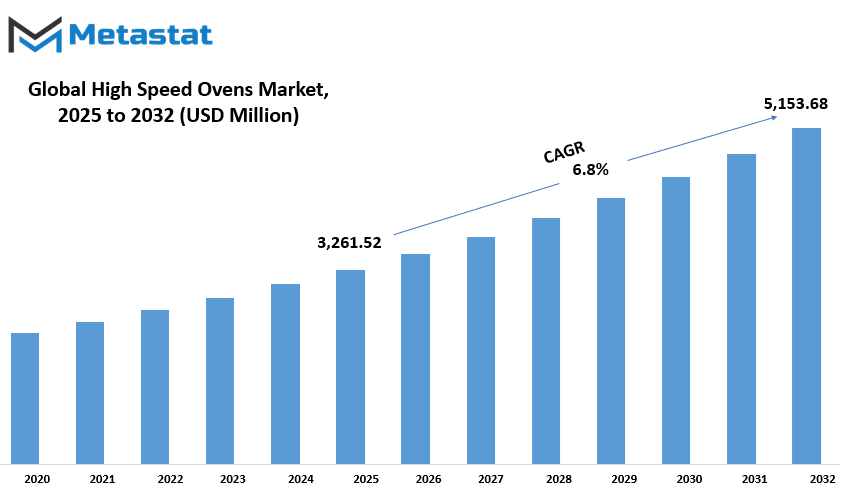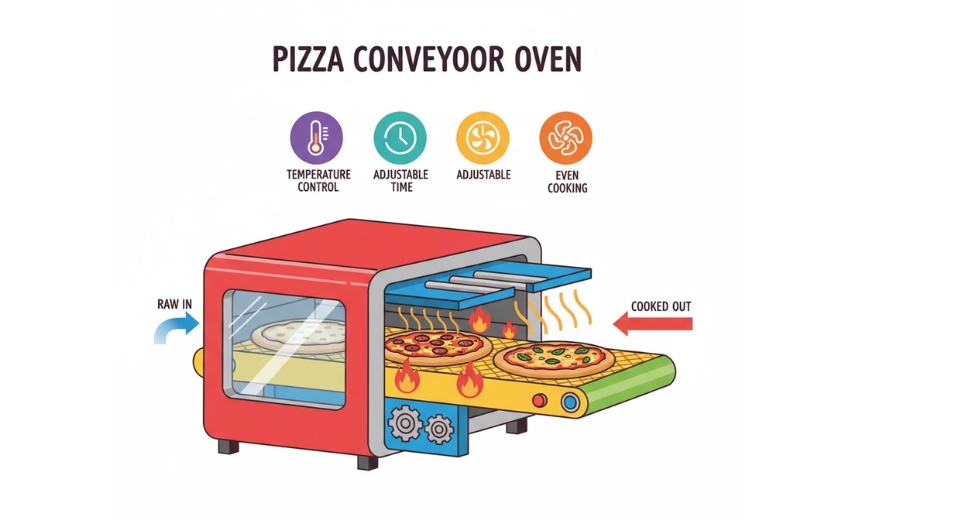MARKET OVERVIEW
The Global High Speed Ovens market will keep pushing the envelope of new kitchen appliances today, shaping emerging standards in the culinary and foodservice industry. With companies entering unexplored functionalities and smart integrations, the future of this market will be far-reaching beyond its present-day consumer base. No longer limited to commercial kitchens or fast food alone, high speed ovens will be set to reach niche markets demanding precision, consistency, and lean technology.
One of the most promising directions the Global High Speed Ovens market is taking is towards personalization and automation. With linked technologies and learning sensors, next-generation models will be designed to learn from usage patterns, creating smarter control systems. Such attributes not only simplify the processes in commercial kitchens but also suit small-scale consumers who appreciate time without sacrificing quality. As the ovens grow more intelligent, their purpose will shift from that of a speed tool to one of culinary art and technique, allowing chefs to tap into more complex recipes with reduced preparation time.
Increased demand for sustainability will make its mark on use and design. The Global High Speed Ovens market will be forced to respond to international demands for reduced energy usage and lower carbon emissions. Future models of these ovens will be built with materials that improve thermal efficiency, and patches to the software will help manage energy usage during off-peak hours. As families and businesses become more environmentally conscious, these ovens will be redesigned to meet stricter environmental standards, creating models that are not only fast, but also eco-friendly.
New geographical markets will emerge as active players in defining this market. Hitherto controlled by developed economies, the Global High Speed Ovens market will begin to feel the demand of the emerging economies where shifts in consumer pattern, urbanization, and demand for hybrid cooking techniques will facilitate greater adoption. This growth will require design customization and price-sensitive models, particularly for small living rooms and other voltage requirements.
At the same time, software and firmware creation will become the key to making market leaders shine. Unlike the previous years when hardware literally ruled the value scene, the future phase shall see greater focus on digital upgrades. Cloud-based diagnostics, recipe-sharing platforms, and cross-device synchronization will turn these ovens into smart cooking stations rather than standalone devices. Customers will expect simple experiences with control accessible via mobile apps, voice commands, or touchless sensors, forcing manufacturers to think outside mechanical limitations.
The Global High Speed Ovens market will also affect related industries like packaging and food preparation, as companies align their businesses with quick cooking formats. The ability of packaging materials to withstand hot temperatures and rapid cooking cycles will become an area of importance, influencing decisions far upstream in the food production supply chain. This conjoined development will underpin the strategic role of high speed ovens across industries, from ready-to-eat meal packers to gourmet delivery restaurants.
As the market evolves, what follows will be compelled not only by demand for efficiency but by a wide cultural shift toward intelligent, responsive, and sustainable kitchen environments. Along the way, the Global High Speed Ovens market will redefine convenience, expand its application, and become even more integral to the infrastructure of next-generation food systems.
Global High Speed Ovens market is estimated to reach $5,153.68 Million by 2032; growing at a CAGR of 6.8% from 2025 to 2032.

GROWTH FACTORS
The global high speed ovens market is evolving steadily, mostly due to the rising demand for more rapid and convenient food cooking. Around the globe and even within household kitchens and restaurants, people demand devices offering time saving in lieu of not sacrificing food quality. This kind of demand is actively prevalent in urban areas, as people there are so busy in their life that they don't have enough time to perform time-consuming traditional cooking. Their efficiency and speed are just what this demand requires, heating food quickly and evenly with the use of microwave and convection technology. As people move into cities and change their lifestyles, they are seeking new, technologically advanced kitchen appliances that are fast and efficient.
The growing demand for smart technology in the kitchen is another market driver. With the rise in popularity of smart homes, consumers increasingly turn to IoT-enabled appliances. This comprises high-speed ovens with smart features like remote control via voice assistants or mobile apps. This shift towards the smart kitchen is opening up new opportunities for the high-speed ovens market as companies retaliate with more convenient products and better performance.
Though there is a good prognosis, a few issues still plague the market. The price of these ovens is one of the main concerns. For most consumers, especially in budget-sensitive zones, the initial expense is too much. Though the long-term benefits may be inviting, not everybody can or will pay a substantial amount. Another constraint is the lack of awareness in certain developing areas. Numerous people remain uninformed about how high-speed ovens work or what benefits they deliver, preventing them from adopting it in such markets.
Yet, there are glaring opportunities for growth. One of the most substantial is within the foodservice market. Quick-service restaurants, in particular, are looking for ways to optimize their kitchen operations and speed service up without cutting back on quality. High-speed ovens help meet these goals by shortening cooking time, an added benefit in busy kitchens. While the demand for speedy food and rapid service continues, so does the market opportunity for high-speed ovens in this sector. Combined with the diffusion of smart kitchens and growing interest in new cookery technologies, the market must develop further over the next few years.
MARKET SEGMENTATION
By Type
Global High Speed Ovens market is growing gradually with the growing demand for quick, effective cooking technology within domestic as well as commercial spaces. With lives becoming busier, time-saving appliances are in growing demand without compromising the quality of the food. High speed ovens meet this demand by using state-of-the-art heating technologies to cook food in a fraction of the time as traditional ovens. These ovens are most commonly found in restaurants, cafeterias, and quick service chains where speed and consistency are most valued. They're also increasingly being adopted in household cooking areas with individuals looking for intelligence and convenience-saving options. The market is divided based on type of oven into combination ovens, convection ovens, and impingement ovens. Convection ovens with a value of $609.27 million employ fans that circulate hot air to cook food evenly and quickly.
This category is popular because it shortens cooking time without any sacrifice in quality. Combination ovens, named as such, incorporate different means of heating—often a mix of microwave and convection technology. This causes them to cook faster, hence proving to be a favorite among fast-paced commercial kitchens where food has to be cooked quickly without a loss in flavor or texture. Impingement ovens, on the other hand, propel hot air onto food at very high speeds. This is especially appropriate for foods like pizzas and sandwiches, where a crisper finish is required within a short period. There are several drivers for the expansion of this market. Changes in dietary habits, increased investments in kitchen automation, and the development of food delivery chains are all contributing significantly.
Businesses are more interested in reducing waiting times and improving the quality of service, and these ovens assist with that. Energy efficiency is another significant benefit since high-speed ovens use less energy than traditional ones in the same amount of time. This reduces the operating expense and improves sustainability efforts. Businesses are also looking to improve user interfaces, adding smart functions, and miniaturizing ovens to fit smaller spaces. Since growing numbers of consumers and companies are realizing the significance of saving energy and time, the Global High Speed Ovens market will increase in size further. As information becomes more and more widespread, rising incomes, and better technology, the market will incline to receive greater attention in business and home usage.
By Application
Divided by application, the market is comprised of baking, grilling, and reheating. Baking is still one of the most widespread applications of high speed ovens, particularly in the food sector. The ovens enable businesses to preheat baked goods such as pizzas, bread, and pastries quicker, enable them to work more efficiently and decrease clients' waiting time. Grilling is also an extremely popular application where the ovens enable foods like vegetables, meat, and crunchy-textured vegetables to cook swiftly with grilled texture and taste.
Reheating too is a large business in the market since high speed ovens heat the food evenly and very fast and are perfectly suited for establishments that offer pre-cooked foods or takeaways. Increasing demand for convenience, particularly in cities, is still driving demand for these ovens. They save time and are simple to use, which is perfectly suited for individuals who have busy lives. For restaurants and food outlets, high speed ovens can also serve to maximize kitchen efficiency while reducing cost of operations by minimizing the cooking time and reduce the utilization of different appliances. They can also be of great use in the home for quick preparation of meals for people who have no time to wait for meals to cook.
Besides performance, companies are also coming up with sleek and compact designs, making the ovens ideal for small applications. With increasing awareness of energy consumption and the environment, energy-efficient designs are also being adopted. This revolution is redefining the future of industry, prompting the manufacturing of products that provide a balance of speed, quality, and energy consumption.
Generally, the market for high speed ovens is bound to continue growing because there is heightened demand for rapid, effective, and compact cooking technologies. Baking, grilling, and reheating are its major applications, and hence the market still caters to the rising needs of residential and commercial consumers.
By End User
The Global High Speed Ovens market is seeing consistent growth with growing demand for faster food preparation without compromising quality. One of the major drivers of this growth is the manner in which different businesses are utilizing these ovens to enhance their service and efficiency. Commercial kitchens are one of the major end-users. They are the backbone for restaurants, hotels, and catering businesses, where consistency and time are everything. In such places, high speed ovens are a luxury because they save time and keep food fresh in taste and quality cooked. They enable chefs to cook faster, especially during peak hours, and improve how the kitchen operates. Quick-service restaurants, or QSRs, are also a huge consumer of high-speed ovens.
These eateries concentrate on offering fast food, and they need appliances that will live up to the demands of the clients. Speedy speed ovens will help QSRs serve hot meals more quickly, satisfying clients as well as helping the business complete more orders within a short span of time. This kind of efficiency is important in the fast-food industry, where quality and speed are essential. These ovens also make it easy to achieve consistency from place to place, and that is a big plus for franchise chains. High-speed ovens are also starting to be used in retail outlets, especially those with ready-to-eat or heat-and-eat food. As more people look for convenient food, stores value having the ability to cook food right away.
|
Forecast Period |
2025-2032 |
|
Market Size in 2025 |
$3,261.52 million |
|
Market Size by 2032 |
$5,153.68 Million |
|
Growth Rate from 2025 to 2032 |
6.8% |
|
Base Year |
2024 |
|
Regions Covered |
North America, Europe, Asia-Pacific, South America, Middle East & Africa |
REGIONAL ANALYSIS
The global High Speed Ovens market may be segmented based on region in an attempt to understand the market's performance across different regions in the world. Segmentation makes it possible for manufacturers and also investors to track growth, demand, and sales within a given region. The North American region is one of the largest, with further subdivision into the U.S., Canada, and Mexico. These countries require highly advanced kitchen equipment in significant quantities, and high consumer awareness leads to steady growth here. Europe is a prime market and includes the UK, Germany, France, Italy, and the Rest of Europe. Demand here is supported by established foodservice markets, technology, and growing momentum toward quick and convenient cooking solutions.
Moving to Asia-Pacific, the region comprises of India, China, Japan, South Korea, and Rest of Asia-Pacific. The market in this region is expanding rapidly due to urbanization, rising disposable incomes, and growth in interest in time-efficient kitchen devices. With an enormous population base and rising adoption of modern cooking methods, countries such as China and India are experiencing strong growth in the usage of high speed ovens. In South America, Brazil and Argentina are the key markets, followed by Rest of South America. The market in the region is still underdeveloped, but higher growth in the foodservice industry and changed lifestyle trends are helping drive demand up.
Middle East & Africa is segmented into GCC Countries, Egypt, South Africa, and the Rest of Middle East & Africa. The Middle East & Africa are growing steadily, with the urban regions and hospitality industries taking the lead in adopting high-speed ovens. The UAE and Saudi Arabia in the GCC region are interested in new kitchen technologies, while South Africa is among the leading nations in the African continent.
By dividing the market into these specific countries and regions, businesses are able to better focus their strategies and tailor their products to fit local requirements. It also helps facilitate more precise analysis of market trends and competition. Having a knowledge of the unique features of each region generates rich data regarding how the global High Speed Ovens market will evolve and where the most durable opportunities will appear in the forthcoming years.

COMPETITIVE PLAYERS
Global High Speed Ovens market is growing steadily as people and companies increasingly demand quicker, more efficient cooking technology. Ovens are particularly designed to save time without affecting the quality of food, so they are gaining popularity in home as well as commercial kitchens. With technology continuing to advance, high speed ovens now have a mix of microwave, convection, and occasionally infrared heating. This combination cooks meals much quicker than traditional ovens, and with no loss of taste and texture. They are especially useful in food service and restaurant use where speed is paramount.
Market leaders in the High Speed Ovens industry are leading the way with ongoing innovation and product improvements. Merrychef, TurboChef Technologies, Inc., and Panasonic Corporation are few among the most renowned companies famous for producing highly efficient and tech-savvy ovens designed according to modern needs. Electrolux Professional AB and Miele & Cie. KG are equally famous for placing user-friendly controls and energy-saving technology in their appliances. Such features make the kitchen more efficient to run with minimal wastage of energy. Sharp Corporation and Bosch Siemens Hausgeräte (BSH) have also established themselves well in the market, with designs focusing on performance as much as looks.
Other companies like Amana Commercial (ACP, Inc.), Smeg S.p.A., and UNOX S.p.A. are also gaining attention for focusing on space-saving and compact designs without sacrificing power. These kinds of models prove to be highly beneficial in small kitchens or businesses ready to maximize space. Hobart GmbH and LAINOX Ali Group S.r.l. are yet another pair of firms that continue to demand performance and reliability improvement of their appliances. With competition growing more stringent, these brands are working even harder to deliver value in terms of durability, speed, and easy-to-use features.
With demand growing continuously, the High Speed Ovens market is sure to grow even bigger. Customers want to heat food quickly but still enjoy a meal, and businesses need equipment that enables them to serve customers more quickly. The industry is being driven by these needs, and manufacturers are changing their strategy in order to stay ahead. With intelligent controls to minimalist designs, businesses are focusing on what customers really want. Over the course of the next few years, we can expect continued refinement of both form and function, as high speed ovens become an integral part of modern cooking.
High Speed Ovens Market Key Segments:
By Type
- Convection Ovens
- Combination Ovens
- Impingement Ovens
By Application
- Baking
- Grilling
- Reheating
By End User
- Commercial Kitchens
- Quick-Service Restaurants (QSRs)
- Retail Stores
Key Global High Speed Ovens Industry Players
- Merrychef
- TurboChef Technologies, Inc.
- Panasonic Corporation
- Electrolux Professional AB
- Miele & Cie. KG
- Sharp Corporation
- Bosch Siemens Hausgeräte (BSH)
- Amana Commercial (ACP, Inc.)
- Smeg S.p.A.
- UNOX S.p.A.
- Hobart GmbH
- LAINOX Ali Group S.r.l.
WHAT REPORT PROVIDES
- Full in-depth analysis of the parent Industry
- Important changes in market and its dynamics
- Segmentation details of the market
- Former, on-going, and projected market analysis in terms of volume and value
- Assessment of niche industry developments
- Market share analysis
- Key strategies of major players
- Emerging segments and regional growth potential








 US: +1 3023308252
US: +1 3023308252






